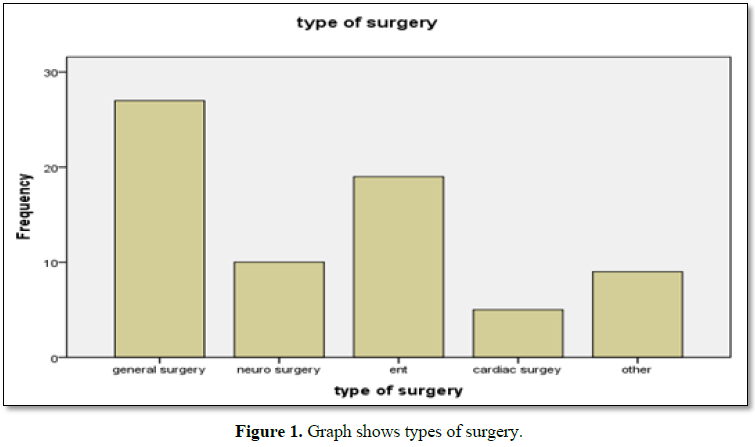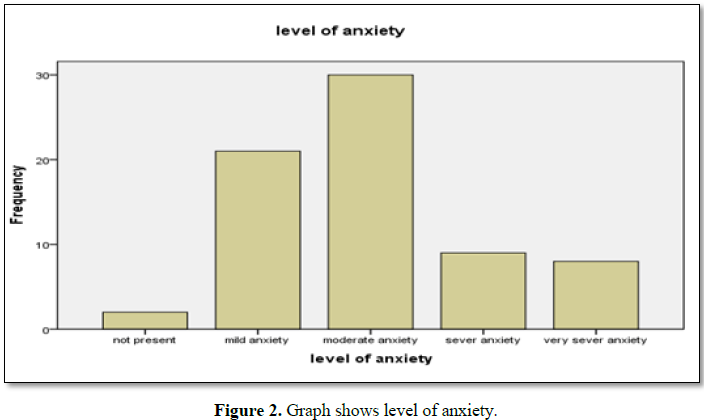1129
Views & Citations129
Likes & Shares
Objective: The objective of the study is to assess the anxiety level among
preoperative patients.
Methodology: The research design used for this study is a
quantitative descriptive cross-sectional study. Hamilton anxiety rating scale
was used to identify the anxiety level of patients, data was collected through
convenience sampling technique and analysis was done by SPSS version 22.
Results: Out of all 70 participants 2.9% has no anxiety, 30.0% have mild
anxiety, 42.9% have moderate anxiety 12.9% have severe anxiety and 11.4% have
very severe anxiety.
Conclusion: The anxiety level of patients varies from mild to moderate, severe and
very severe. Different factors like gender, level of education of the
participants and type of surgery affect the level of anxiety. Worried about
pain and operation theater environment also effect anxiety level. The study
also addresses some recommendation to reduce anxiety in preoperative patients.
INTRODUCTION
Anxiety is uncomfortable feeling of apprehension or dreads that occurs
in response to internal or external stimuli and can result in physical, emotional,
cognitive and behavioral symptom (Mary Ann Boyd 5th Edn).
A normal emotional response to anxiety consists of three parts
physiological arousal, cognitive process and coping strategies. Physiologic
arousal or the fight-or-flight response is the signal that an individual is
facing a threat.
Cognitive processes decipher the situation and decide whether the
perceived threat should be approached or avoided. Coping strategies are used to
resolve the threat.
Preoperative anxiety
Preoperative anxiety is a challenging problem in the preoperative
patients all over the world. A number of patients experience anxiety when they
go for elective surgery [3]. Anxiety being an unpleasant state of uneasiness
may be lead to abnormal hemodynamics status that is the result of sympathetic,
parasympathetic and endocrine stimulation.
Preoperative anxiety is a challenging concept
in the preoperative care of a patient. Most of the patients waiting for
elective surgery experience anxiety and it is an expected response; they
experience anxiety at the day of surgery because they think it as the biggest
and the most threatening day in their lives. The degree of preoperative anxiety
in the patients depends upon many factors, i.e., age, gender, type and extent
of proposed surgery, previous surgical experience and personal susceptibility
to stressful situation.
In Portugal by Batista dos Santos [1], the
levels of anxiety, depression and stress in preoperative surgical patients and
analysis; their correlation with some socio-demographic and surgical process
show low level of anxiety, stress and depression among surgical patients in the
preoperative procedure. The results also show statistically significant
relations between anxiety and academic qualifications and also between anxiety
and length of hospital stay.
Study conducted in Turkey by Yilmaz et al. [5]
suggests that women, illiterate patients, and patients that receive only
limited family support, or that live alone may need additional support and care
for moderate levels of surgery. Therefore, nurses should identify patients that
have high anxiety levels and facilitate them and their family members to reduce
their anxiety.
In addition, nurses should evaluate
preoperative anxiety and fear and encourage patients to talk about their
feelings while providing time to listen it.
Matthias et al. [4] in Sari Lanka, studied and
found that females were more anxious; and also those who had never undergone
surgery were more anxious as compared to those who had experienced of surgical
procedure. It has highlighted that information regarding surgery and anesthesia
might help in reducing the preoperative anxiety levels.
Study on the same topic conducted by Jawaid et
al. [3] at Karachi to find out the prevalence of preoperative anxiety among
patients undergoing through surgery in Pakistani context. Factors associated
with anxiety level among surgical patients are concerning family fear of
complications and postoperative pain in surgery. The respondents thought that
their anxiety would be reduced by a detailed explanation regarding surgery and
anesthesia.
Anxiety can be easily measured in the
preoperative period. Certain tools are available for measuring it, using a
standard tool will help to measure the detection of patients with high anxiety
and taking appropriate step to reduce anxiety.
As it is clear from the above published
literature that patient that goes through surgical procedure are anxious and in
stress condition. To find the prevalence and extent of anxiety among patient
from KPK, the study is planned; it will also highlight the factors associated with
anxiety level among preoperative patient in local context. As very limited work
on preoperative anxiety in Peshawar is available so the study will also help
the management of both public and private sector hospitals to make policies for
reducing anxiety among preoperative patients. It will also highlight the need
of establishment of preoperative counseling clinics and properly informed
consent taken before surgery for reducing preoperative anxiety.
METHODOLOGY
Study design
The research design used is a quantitative
descriptive cross-sectional design. This type of study design might be best use
when the researcher is interested to gather the information at one point in
time. It provides a snapshot of the population.
Population and setting
The two hospitals, one from public sector and
second from private sector of Peshawar were selected for the study. The study
population included patients of different surgical process.
Sampling technique
A convenient sampling technique is used for
sampling collection.
Sample size
Sample size of this study was 70. As
calculated by Rao soft software with 95% confidence level, 5% margin of error
and 5% non-responsive rate.
Inclusion criteria
Adult patient undergoing through surgery.
Exclusion criteria
The patient with a neurological problem
(mentally retorted) and unconscious patients. Patients with language barriers
are excluded.
Data collection tool
Self-Adopted questionnaire consisting Hamilton
anxiety rating scale was used for data collection. The questionnaire was consisting
of six questions about the predictors which increases and decreases the anxious
level of the patients.
ETHICAL CONSIDERATION
Approval for the data collection was taken
from the chief nursing supervisor of the hospitals. An informed consent was presented
and explained to each participant for his or her agreement as a participant.
Anonymity was guaranteed to all the participants. Data were kept locked under
password. Only primary data collectors and supervisor had access.
Confidentiality was maintained through-out the study.
DATA ANALYSIS
Social package for social sciences (SPSS)
version 22 was used for data analysis. For nominal and ordinal data
Frequencies, percentage, were calculated while for continuous data mean and
standard deviations were calculated. Chi square was used for identifying
whether there is any association between anxiety level and other categorical
variables.
RESULTS
Chi square was applied to identify any association between different categorical
variables with the level of anxiety, that also a categorical variable. The
significant association was observed between education level of the participant
and their anxiety level with a p-value of 0.001.
DISCUSSION
Study conducted in Portugal identified low level of anxiety, stress and
depression among surgical patients in the preoperative procedure [1]. Current
study shows that 2.9% participants have no anxiety, 30.0% have mild anxiety,
42.9% have moderate anxiety 12.9% have severe anxiety and 11.4% have very
severe anxiety.
Another study by Yelmaz et al. [5] showed the mean anxiety score of the
patients was 31.91 + 6.30. In current study the percentages of patients’
anxiety levels were calculated where 2.9% has no anxiety, 30.0% have mild anxiety,
42.9% have moderate anxiety 12.9% have severe anxiety and 11.4% have very
severe anxiety.
A study conducted by Javeed et al. [3] highlights the common factors
contributing to anxiety are concerning family, fear of complications and
postoperative pain in surgery. Mean anxiety score for surgery was 57.65 ± 25.1
and for anesthesia was 38.14 ± 26.05. There was a statistically significant
high level of pre-operative anxiety in females as compared to males
(p<0.01). The most common factors contributing to anxiety were concern about
family in 173 (89.6%) patients, fear of Complications in 168 (87%), results of
operation in 159 (82.4%) and postoperative pain in 152 (78.8%). Fifty six
percent of patients thought that their anxiety would be lessened by a detailed explanation
regarding the operation and anesthesia [3].
While our current study consists of 70 participants including 39 (20.6%)
male and 31 (16.4%) female. Age of participants was ranged between 19 to 75
years with a mean 39.43 and SD deviation is +16.266. As for as the education
level of the participants is concern 23 (32.9%) were uneducated, 10 (14.3%) had
primary level of education, 27 (38.6%) were matric level, 6 (8.6%) were
graduate and the remaining 4 (5.7%) have master level of education. The
patients were selected from general surgical, neurological wards, cardiac
wards, ENT wards and other surgical wards 78.6%, of the participants stated
that they are afraid of surgical procedure, 74.3% also accepted that they are
afraid of operation theater environment. While the participants worried about
post operation pain were 70%.
Percentages of patients’ anxiety levels were calculated where 2.9% has no
anxiety, 30.0% have mild anxiety, 42.9% have moderate anxiety 12.9% have severe
anxiety and 11.4% have very severe anxiety.
A study by Matthias et al. [4] comprised of 100 participants (male 36 and
female 64) the age varied from 25 to 75 years (mean 48.7 years, SD 13.6). The
score of APAIS show that anesthesia related anxiety (mean 4.63, SD 2.65)
surgery related anxiety (mean 4.17, ST 2.53) information desire component mean
7.49, SD 3.19) total anxiety score (mean 15.60, SD 7.08). Female were more
anxious than male (p=0.20) and those who had never sustained surgery were more
anxious than those who had previously had surgery (p=0.05). The anesthetist’s
visit could reduce anxiety [4].
Current study consists of 70 participant including 39 (20.6%) male and 31
(16.4%) female. Age of participants was ranged between 19 to 75 years with a
mean 39.43 and SD deviation is +16.266. As for as the education level of the
participants is concern 23 (32.9%) were uneducated, 10 (14.3%) had primary
level of education, 27 (38.6%) were matric level, 6 (8.6%) were graduate and
the remaining 4 (5.7%) have master level of education. The patients were
selected from general surgical, neurological, and cardiac, ENT and other
surgical wards 78.6%, of the participants stated that they are afraid of
surgical procedure, 74.3% also accepted that they are afraid of operation
theater environment. While the participants worried about post operation pain
were 70%. Percentages of Patients’ anxiety levels were calculated where 2.9%
has no anxiety, 30.0% have mild anxiety, 42.9% have moderate anxiety 12.9% have
severe anxiety and 11.4% have very severe anxiety.
It is clear from the above published literature that patient that goes
through surgical procedure are anxious and in stress condition. Current study highlighted
the factors associated with anxiety level among preoperative patient in local
context. As very limited work on preoperative anxiety in Peshawar is available
so the current study will also help the management of both public and private
sector hospitals to make policies for reducing anxiety among preoperative
patients. It will also highlight the need of establishment of preoperative
counseling clinics and properly informed consent taken before surgery for
reducing preoperative anxiety.
CONCLUSION
1.
dos Santos MMB, Martins A, Carlos J, Nunes Oliveir
LM (2014) Anxiety, depression and stress in the preoperative Surgical patient.
Revista de Enfermagem Referência 4.
2.
https://en.wikipedia.org/wiki/Hamilton_Anxiety_Rating_Scale
3.
Jawaid M, Mushtaq A, Mukhtar S, Khan Z (2007)
Preoperative anxiety before elective surgery. Neurosciences 12: 145-148.
4.
Matthias AT, Samarasekera DN (2012) Preoperative
anxiety in surgical patients-experience of a single unit. Acta
Anaesthesiologica Taiwanica 50: 3-6.
5.
Yilmaz M, Sezer H, Gürler H, Bekar M (2012)
Predictors of preoperative anxiety in surgical inpatients. J Clin Nurs 21:
956-964.
QUICK LINKS
- SUBMIT MANUSCRIPT
- RECOMMEND THE JOURNAL
-
SUBSCRIBE FOR ALERTS
RELATED JOURNALS
- Journal of Alcoholism Clinical Research
- Dermatology Clinics and Research (ISSN:2380-5609)
- Journal of Cell Signaling & Damage-Associated Molecular Patterns
- International Journal of Clinical Case Studies and Reports (ISSN:2641-5771)
- Journal of Immunology Research and Therapy (ISSN:2472-727X)
- Oncology Clinics and Research (ISSN: 2643-055X)
- Ophthalmology Clinics and Research (ISSN:2638-115X)



